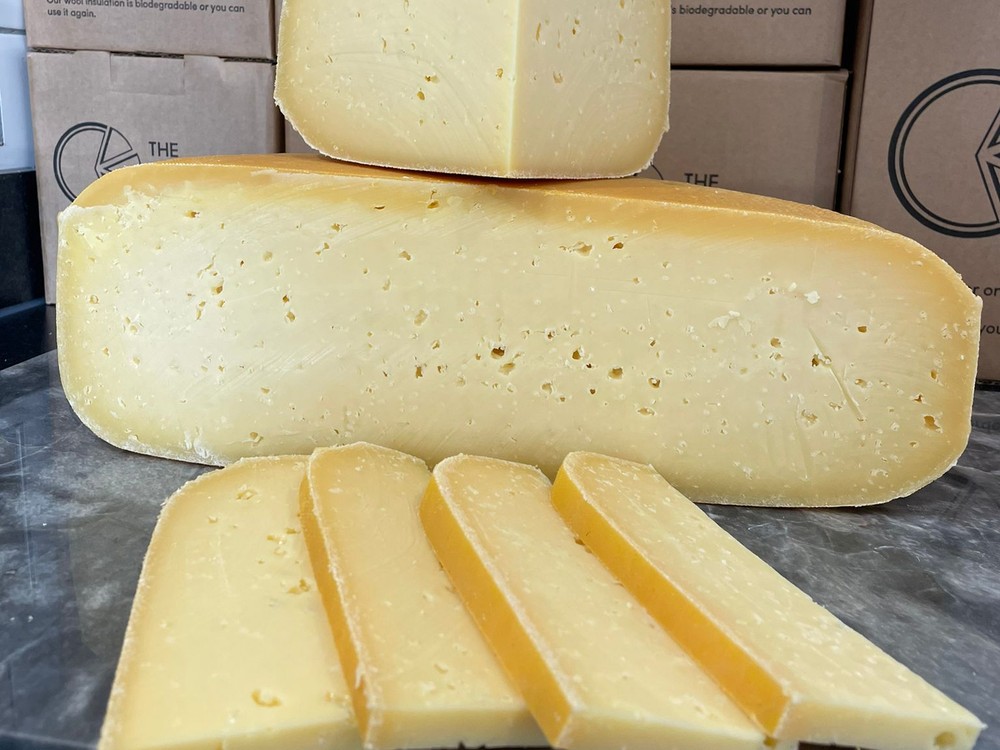Grana Padano
What is Grana Padano?
Grana Padano is a hard Italian cheese that is similar to Parmesan. It is named after the Grana (grainy) texture of the cheese and the Padano region in northern Italy where it originated. Grana Padano has been produced for over 1,000 years and is one of the most popular and widely consumed cheeses that has received the Protected Designation of Origin (PDO) status.
How is Grana Padano Made?
Grana Padano is made from unpasteurised, semi-skimmed cow’s milk, and is aged for a minimum of 9 months, but some varieties can be aged for up to 24 months or more. It has a firm, granular texture, which becomes crumbly as it ages. The flavour is savoury, nutty, and slightly sweet. The longer it is aged, the more intense and complex the flavour becomes. Grana Padano has a pale yellow or straw-coloured interior with a natural rind. It is available at different ripening stages: Grana Padano (9 to 16 months), Grana Padano oltre 16 mesi (over 16 months) and Grana Padano Riserva (over 20 months).
Grana Padano can be grated over pasta, risotto, salads, or soups. Try pairing the cheese with a Barolo, Zinfandel or Gavi white wine.
What Does Grana Mean?
Grana refers to a family of hard, mature cheeses from Italy with a granular, flaky texture and are mainly used for grating. Around the world, Grana is a generic term used to define three main varieties of cheeses namely - Parmigianino Reggiano, Grana Padano and Grana Trentino and other smaller variants like Granone Lodigiano, Trentingrana and Gransardo. However, in Europe, the word 'Grana' is legally protected by Grana Padano Protected Designation of Origin. Only Grana Padano can use the term to sell its produce in EU countries.
The most popular Grana Italian cheeses are of course Parmigiano Reggiano and Grana Padano. True Parmigianino Reggiano, named after the Provinces of Parma, Reggio Emilia, Modena, Bologna and Mantua, where it is produced, has a hard, gritty texture and is fruity and nutty in taste.
On the other hand, Grana Padano refers to the valley Pianura Padana where it is made. Though similar to Parmigianino Reggiano, young Grana Padano is slightly less crumbly, milder and less complex than its famous, aged kin. On the other hand, Grana Trentino follows the same method to produce Parmigianino Reggiano but is made in the province of Trento, giving it its name.
All three main varieties of Grana cheese carry the label DOP. (Denomination of Protected Origin), guaranteeing their authenticity and origin of production methods.
FIND WHAT YOU'RE LOOKING FOR

Over 200,000 page views per month, Put your store on our map!
Contact UsOther Italian cheeses:
Grana Padano, a hard and aged Italian cheese with a granular texture and nutty flavour, pairs well with a variety of wines and crackers. Here are four wine types and three cracker options that generally complement Grana Padano:
Wine Pairings:
- Barolo: This robust and full-bodied red wine, made from Nebbiolo …
Risotto with Grana Padano, Asparagus and Lemon
This exquisite dish combines the nutty richness of Grana Padano cheese, the vibrant essence of fresh asparagus, and the zesty allure of lemon, resulting in …
Here you will find some alternatives to help you replace the Grana Padano cheese in your main dishes or your cheese board. Read More
Grana Padano Q & A
-
Can I eat Grana-padano cheese when pregnant?
Grana Padano cheese is generally considered safe to eat during pregnancy. Grana Padano, like Parmigiano Reggiano and many other …
Read More -
What are the main differences between Grana Padano and Parmigiano Reggiano cheeses?
- Origin: Grana Padano originates from the Po River Valley, while Parmigiano Reggiano comes from specific regions in Italy, including …




